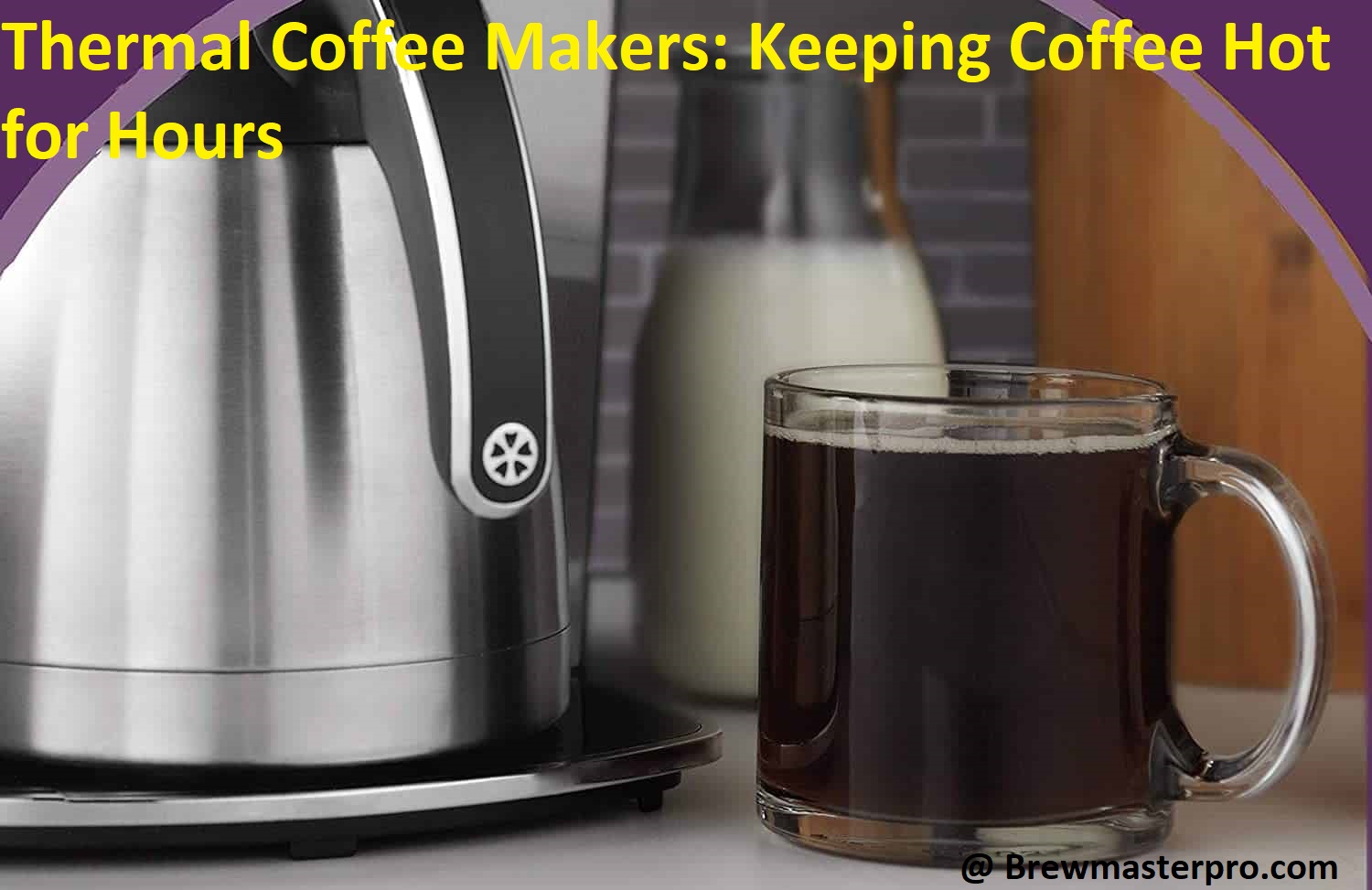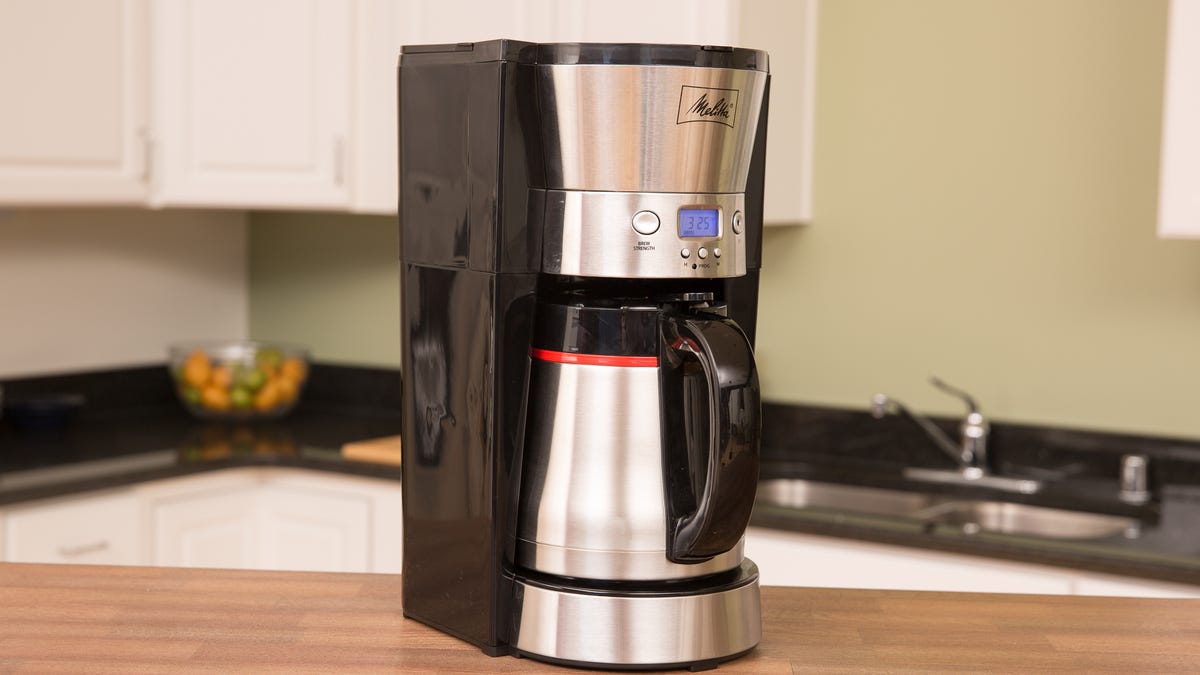Are you tired of your coffee getting cold quickly? Do you want a cup of hot coffee to enjoy hours later?
Thermal Coffee Makers could be your perfect choice! With this complete guide, you’ll be able to find the
Welcome to this guide to thermal coffee makers. For many coffee lovers, the best cup of joe is one that contains very fresh, craft-brewed beans. The appreciation of truly good coffee has lead to an interest in professional grade espresso makers, pour-over brewers and filter systems. But no matter how good the freshly brewed cup of coffee tastes, it loses temperature quickly and soon reaches lukewarm levels – if not cold – when sitting idle just a few minutes.
In order to be able to divulge in a hot cup of Joe throughout the day without having to prepare it every few minutes, people often turn towards thermal carafes, or “thermoses”. Thermal carafes offer commonly two major features: jug-like construction with a snug lid (meant for carrying around) and insulation which guarantees that your beverage stays at the desired temperatures for hours.
This guide will reliably inform you about what thermal carafes are available on the market today, what they offer and which potential key features you should consider before buying one. Each individual section is dedicated with providing answers and advice on different aspects of thermal carafes – from design to cost efficiency.
How Thermal Coffee Makers Work
Thermal coffee makers combine a standard drip-style brewer with an insulated carafe in order to keep brewed coffee hot for several hours. Most thermal coffee makers feature an automatic shutoff switch that turns the device off after it has been brewing for two to three hours. At this point, the temperature of the carafe’s contents should still be between 145–175 degrees Fahrenheit (62–79 degrees Celsius).
The basic inner workings of thermal coffee makers involve two main components:
- brewing basket, and
- thermal carafe.
The brewing basket is typically designed to hold enough coffee grounds to make eight or more cups of coffee and can often accommodate either pre-measured paper filter holders or permanent metal filters that can simply be filled with freshly ground beans. The water reservoir contains enough water to make 8–12 cups of coffee and is connected via a tube to the brewing basket. When you push down on the “brew” button, water moves through the tube, saturating the grounds and then dripping into the carafe below. Once all of the water has been transferred from reservoir to carafe, heating elements (which are usually located along the sides of both components) switch off automatically, preserving your perfectly brewed pot of joe until you’re ready for it later on!

Explanation of the heating mechanism
Thermal coffee makers are great for those who want to serve their guests or simply enjoy their own aromatic cup of java for hours without any fear of the flavor diminishing with time. These coffee makers come equipped with special insulation technology that keeps your brewed coffee hot for several hours.
The heating mechanism used in thermal coffee makers is double-walled vacuum insulation, wherein two stainless steel walls are placed around the carafe, which separate internal and external environments. This technique allows the device to insulate heat while simultaneously blocking out cold temperatures from the environment.
Inside the interwalls, a vacuum removes all possible air particles, thus ensuring minimal thermal conduction between the inner and outer layers. This helps maintain the internal temperature of your brewed beverage without much energy loss. Additionally, due to this innovation in technology, you no longer have to worry about overboiled portions in case you forget about your brewing — thanks to thermal insulation!
Types of heating mechanisms
There are two main types of mechanisms for heating coffee: direct and indirect. Direct heat uses metal elements that transfer heat directly to the coffee, while indirect heat employs a liquid-filled conductor to absorb and distribute the thermal energy. Both methods will effectively keep your coffee warm for hours, but direct heating is generally considered quicker and more efficient.
Direct Heating: Directly heated thermal carafes work by passing electrical current through metal elements embedded in the body of the carafe itself. During operation, these metal elements heat up to produce a steady supply of hot water which is used to maintain the temperature of your coffee. The advantage of this approach lies in its ability to quickly bring coffee up to serving temperature, but this means a greater level of risk due to high temperatures which can scald or even burn if handled incorrectly.
Indirect Heating: In contrast, an indirectly heated thermal pot requires an external source of energy in order to keep your coffee hot. This mechanism consists of a liquid-filled conductor surrounding an insulated cylinder which contains your coffee. As the heat from an external source warms the fluid inside, it is then transferred progressively throughout the surface area around the cylinder – producing gentle and consistent heat which safely maintains any desired temperature over a longer period. In addition, since no power is applied directly to your drink, there is less risk associated with this type of heating mechanism compared with direct heating models.
Choosing the Right Thermal Coffee Maker
When you’re shopping for thermal coffee makers, there are a few features to consider. The size of the machine will depend on how much coffee you intend to make and how many cups you plan on serving. If you’re looking for the convenience of popping a pod into the machine and walking away, you’ll want to choose one with a single-serve option. Also take into account energy efficiency and whether or not your unit has an auto start or timer feature which can save energy and time.
The materials used in construction are also an important factor when it comes to choosing the best thermal coffee maker for your needs. Most models are made of stainless steel which is durable, solid, and attractive. Some thermal carafes are made of glass or plastic for easier maintenance; however these are more fragile than metal options so you may have to decide if style and ease of cleaning is more important than durability.
:max_bytes(150000):strip_icc()/SPR-EATS-10-best-thermal-carafe-coffeemakers-4155216-primary-9e07298acc8b43ec87f0b2effd5ff10f.jpg)
Be sure to take into consideration the method of heating on your brewer as some use old-fashioned warming plates while new technology can provide optimal temperature control aimed at preserving flavor notes in your chosen bean blend. Additionally, not all units feature thermal insulation so if keeping beverages at their highest peak temperature is important to you be sure that’s part of your criteria when narrowing down options. Once all essential components have been compared, it should be easier to make an informed decision based on personal preferences about which model will work best in a given situation.
Consideration of the capacity and usage
Before deciding on a thermal coffee maker, it is important to consider the capacity and intended usage. Different makers have different capacities and sizes, so one should choose a product that fits the need.
For light use or a small household, there is the hourly carafe brew system which will serve up to 12 cups of coffee per hour or up to forty-five 4-ounce cups of coffee at an appropriate temperature all day.
For larger gatherings or commercial settings, there are gallon thermal carafes that make up to 10 gallons of hot coffee at a time and will keep it hot for hours. With either type of maker, there is no need to make multiple pots throughout the day as your last cup served will be as fresh as your first.
Comparison of different models and brands
When it comes to selecting the right thermal coffee maker for your kitchen or workplace, there are various comparison factors to consider. While all thermal coffee makers are designed to keep hot beverages hot for several hours, no two models and brands are exactly the same. To make sure you purchase the perfect thermal coffee maker for your needs and preferences, here is a comparison of different models and brands.
Convenience
Depending on your convenience needs and wants, you can choose from manual, semi-automatic and automatic models. Manual models are great if you want total control over the temperature of your coffee; semi-automatic models provide accuracy with temperature settings; while automatic thermal brewers will prepare up to 12 cups at a time – with minimal effort required on your part.
Materials
When it comes down to materials used in thermal coffee makers, stainless steel is generally seen as the more durable option because of its high corrosion resistance properties. Plastic materials can typically handle temperatures below 200 degrees Fahrenheit (93 degrees Celsius) without too much difficulty but should ideally be BPA-free (Bisphenol A) to ensure a safe brewing experience. Glass material is usually considered less durable than plastic or stainless steel – when using glass material be sure that it is heat resistant instead of tempered glass which can easily shatter in higher temperatures.
Capacity And Size
This factor will be dependent on how many people will be using the brewer and how often you plan on using it. Most machines range from 4–12 cups but there are also machines available that brew up to 30 cups as well as individual single serve units for working or living environments that require smaller capacity batches of coffee throughout the day such as workplaces or hospitality sites like hotels and restaurants. Choosing a model with an ideal size will depend entirely upon where you plan on placing your machine; while most brewers come with adjustable legs some may require special placement due to their physical dimensions and weight whereas other brewers have additional features such as built-in stands, pour-over capability or heating plates – so check out what options suit best before making a purchase decision!
III. Maintenance and Care
Proper maintenance and care of your thermal coffee maker can greatly extend its lifespan and make sure you have a great cup of hot coffee prepared quickly. Following the manufacturer’s instructions on the correct process for cleaning and caring for your unit is important, as each model may be different. Here are some general tips to ensure your thermal coffee maker stays in good condition:
- Clean the carafe regularly with warm, soapy water and a bottle brush if necessary to remove residue. Rinse thoroughly after cleaning.
- Check periodically to make sure there are no clogs or obstructions in the lid or spout that could prevent proper dispensing of coffee.
- Make sure to clean any parts that come into contact with foods, such as filters and lids, with warm soapy water after every use.
- Ensure the carafe is completely dry before closing it up or storing it away for an extended period of time.
- Store your thermal coffee maker away from areas where it will be exposed to extreme temperatures or humidity changes.
Importance of maintenance
Good maintenance and upkeep of thermal coffee makers is essential in order to ensure optimal beverage quality and keep your coffee hot for hours. A few simple steps can increase the lifespan of these devices so you can get more results out of yours. Some important considerations include deep-cleaning, water filters and regular descaling.
Deep-cleaning your thermal coffee maker on a regular basis is necessary to remove any built up residues, oils, or bacteria from the brewing area. With many machines, this can be done by running a half cup of white vinegar along with a full pot of water through the coffeemaker. It’s important to wipe down all external surfaces with a soft cloth regularly as well to keep it looking shiny and new.
Using water filters as part of the boiler is also highly recommended as they help reduce sediments and contaminants such as chlorine or lead that could otherwise make your beverages taste bitter or sour. Additionally, you should be diligent in using distilled or filtered water when refilling the tank, rather than tap water (especially if it has been sitting in an open container).
Finally, descaling your thermal coffee maker goes a long way towards preserving its performance over time. This involves using an acidic solution such as citric acid or vinegar to flush out residue that often accumulates on boilers over time from exposure to calcium carbonate deposits from hard water areas. Be sure to check user’s manuals for specific instructions — some machines require particular procedures for descaling that must be followed for safety reasons.
Steps to maintain a thermal coffee maker
Taking care of a thermal coffee maker is an easy task that only requires a few simple steps to ensure its optimum performance. Follow the listed steps to make sure your thermal carafe coffee maker continues to keep your favorite coffee hot and delicious, while regulating its flavor and freshness.

- Clean the filter basket regularly: Empty out your coffee filter basket and rinse it with warm, soapy water between each use. This will help remove any buildup that can accumulate over time around the filter paper’s crevices, potentially affecting the flavor of future batches of coffee.
- Periodically descale it: Minerals in water can get stuck on walls and surfaces of carafes over time, potentially affecting flavor and leading to corrosion. To prevent this from happening, you should descale or cleanse your carafe at least once a month using a mild vinegar solution or descaling product specifically designed for thermal carafes.
- Check for loose parts: Over time small components like screws can become loose or detach from their origins due to daily wear and tear from typical use; so inspect all of your parts – from cooling plates to handles – every once in awhile to make sure everything is securely fastened before each use for maximum safety and performance assurance.
4 Avoid disassembling components: Stickers, labels or plastic fittings on thermal carafes should not be removed as they ensure a safe closure between sections inside the carafe body – always avoid taking them apart unless necessary for repairs or maintenance purposes as even small alterations could compromise the efficiency of insulation between sections where cold air loss could occur.
Conclusion
In conclusion, thermal coffee makers offer a great way to ensure hot, fresh-tasting coffee for hours after brewing. They don’t require electricity or any type of filter, making them a great choice for homes without access to electricity or running water. And some models even come with added features such as glass carafes that can be used to keep beverages warm for an extended period of time. Plus, thermal carafes are generally quite affordable and easy to use.
So if you’re looking for a convenient and affordable way to keep your coffee hot for hours after brewing, consider investing in a thermal coffee maker today!
FAQ’S
ow long does coffee stay hot in a thermal carafe?
Coffee can stay hot in a thermal carafe for up to 12 hours or more, depending on the quality of the carafe.
How long will coffee stay hot in a coffee maker?
Coffee will usually stay hot in a coffee maker for about 20 minutes to an hour, depending on the type of coffee maker and the insulation quality.
How do you keep coffee warm in a thermal carafe?
To keep coffee warm in a thermal carafe, preheat the carafe, use freshly brewed coffee, and avoid opening the carafe frequently.
How long does coffee stay hot in Cuisinart thermal carafe?
Coffee can stay hot in a Cuisinart thermal carafe for up to 12 hours, depending on the brewing temperature and other factors.
How long do thermal cups stay hot?
Thermal cups can keep beverages hot for up to 6 hours or more, depending on the quality of the cup and the initial temperature of the drink.
Which type of thermos would keep your coffee hot the longest?
Vacuum insulated thermos bottles are generally considered the best type of thermos for keeping coffee hot for the longest time.
What is the advantage of a thermal carafe on a coffee maker?
A thermal carafe on a coffee maker can keep the coffee hot for a longer time, and it also eliminates the need for a hot plate, which can cause the coffee to overheat and develop a burnt taste.
What is the best material to keep my coffee hot the longest time?
Stainless steel is the best material for keeping coffee hot for the longest time, as it is durable, non-reactive, and has excellent insulation properties.
How do you keep coffee fresh in a thermos?
To keep coffee fresh in a thermos, use a clean thermos, store the coffee in airtight containers, and keep the thermos away from heat and direct sunlight.
How does coffee remain hot in a thermos flask?
Coffee remains hot in a thermos flask due to the vacuum insulation, which prevents heat from escaping or entering the flask. The flask’s lid also plays a role in keeping the coffee hot by minimizing heat loss through convection.
See Also-
- Best latte coffee maker 2023
- Best ninja coffee maker 2023
- Best nitro cold brew coffee maker 2023
- Best office coffee maker 2023
- Best percolator coffee maker 2023

